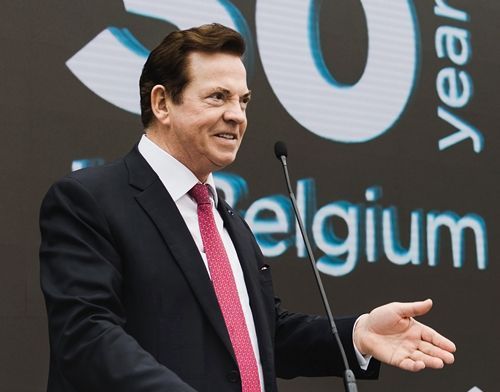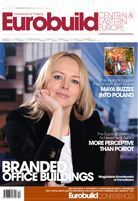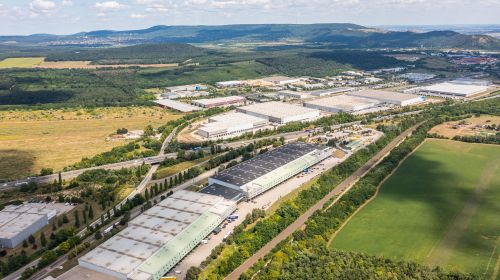More perceptive than Poirot
Eurobuild Awards
In the early 1990s, the CEO of Ghelamco Group started visiting Wrocław to buy construction materials for his Belgian projects. “At the time these products were much cheaper in Poland than in Belgium or other Western European countries,” recalled Paul Gheysens on the pages of ‘Eurobuild CEE’ a few years ago. “However, I could see virtually no modern office space in Poland at the time and the rents in existing buildings were extremely steep – up to USD 40 per sqm, whereas in Belgium the average rate was USD 15. It was clear that the market had great potential and we could not waste such an opportunity,” he says. Looking at Warsaw these days through the window of an office on the 41st floor of Warsaw Spire, Paul Gheysens has the right to think that it’s not only the city’s Wola district the building towers over that is at his feet.
Royal debut
However, the beginnings of Ghelamco’s Polish investment in the early 90s were not the easiest. Twenty years ago the office market in Poland was virtually non-existent and local investors were afraid to launch new projects,” recalls Paul Gheysens. “There were no modern office buildings – even in Warsaw, and there were no districts that could be called business districts. Now that the Polish market has developed, the situation has changed completely. Every year larger and larger office buildings are constructed, while the market has become much more transparent and challenging at the same time. The awareness of tenants has also evolved and they have considerably higher expectations than they did twenty years ago. The financial realities were also completely different in Poland back then. “When I established the company the majority of transactions took place in American dollars and later in Deutschmarks,” he recalls.
Even though the Polish–Belgian connection at Ghelamco started with the import of construction materials from Poland, Ghelamco’s first Polish office project, Green House in Warsaw’s Ochota district, was not made with Polish materials at all. “The situation changed at the time and Polish prices skyrocketed, so we imported materials for the construction of Green House from Belgium,” reveals Jeroen van der Toolen, the CEE managing director of Ghelamco. The project opened with something of a bang as the ceremony, which took place in 1992, was attended by... the king of Belgium. “This happened by chance to a certain extent, but it was certainly augured well for our future on the Polish market,” believes Jeroen van der Toolen. “A few weeks before the opening ceremony, word got out that his Royal Highness would be visiting Poland officially at the same time. Following a call to the ambassador, Paul managed to invite the monarch, who eventually cut the official ribbon to declare Green House open. After such an illustrious launch the building had no problems finding tenants and was soon fully-leased. Shortly afterwards it was sold to the Luxemburg Investment Fund. The building has had no problems finding tenants to this day.
The long way to the spire
The Warsaw Spire complex is, of course, the jewel in the Belgian company’s crown – as well as the crowning of Ghelamco’s operations in Poland. However, not everyone was so confident that the project would be successful – it was expected to fall victim to the excessive supply on the capital city’s red hot office market. In 2006 you needed exceptional faith and intuition to predict that it would be possible to lease over 100,000 sqm a few years later. Despite this, Ghelamco ploughed on with purchasing the plot from a bankruptcy trustee of the Military Graphic Company [Wojskowe Zakłady Graficzne]. The Belgian developer was one of fourteen parties interested in the plot, pushing its price up from PLN 23.4 mln to a staggering PLN 85 mln over the course of the bidding. Such an investment not only seemed risky at the time, but reckless. “Few people in the company understood Paul’s vision – in fact, most of them were terrified,” admits Jeroen van der Toolen. “You need to remember what Wola was like ten years ago: rundown tenements, derelict factories and paralysing traffic jams; the plans for a second metro line were still quite hazy... and yet Gheysens could see the potential for not only thousands of square meters of offices on the shabby site at the junction of ul. Towarowa and ul. Grzybowska but also for a vibrant quarter of the city featuring a public square. “Before we received the building permit in early 2010 we had been planning to start construction work that same year; however, due to the difficult situation on the market we decided to postpone this until 2011,” explains Paul Gheysens.
On the Warsaw Spire’s opening day in May this year, just as the group of invited dignitaries were cutting a computer simulated virtual ribbon displayed on a giant screen that had been installed, 90 pct of the total area of 115,000 sqm was already leased. The tower, constructed for PLN 904 mln, had attracted tenants such as Adecco Poland, Bilfinger HSG Facility Management, BNP Paribas Securities Services, European agency Frontex, Goldman Sachs, JLL, MasterCard and Samsung. The developer expects that the leasing level will have exceeded 95 pct by the end of the year. Europejski Square, which lies the foot of the skyscraper, is filled with the sound of chit-chat and the gurgling of the brightly-lit fountains. “This place should be alive – it should be visited by children and entire families. That’s why we have installed fountains and a few of high-quality restaurants have opened here,” explains Jeroen van der Toolen.
“As a Warsaw resident, I say: yes, I buy it, I like it,” says Andrzej Malinowski, the president of the Employers of Poland confederation. “The concept for the Warsaw Spire was well thought-out and comprehensive. Ghelamco has proved that you can enter the existing structure of a city and create new quality intelligently and cohesively. Warsaw Spire is not a soulless container of thousands of square metres and the employees working in them – there are plenty of those in this city.”
Ghelamco’s own confidence in the quality of its product was demonstrated in September when the company moved its head office from Służewiec to Warsaw Spire. Their premises are now located on the 41st floor of the building, 150m above street-level. Its 2,000 sqm of offices includes a kitchen resembling a golf course and a conference room inspired by the rock band U2.
Not only under a roof
The fact that in Poland Paul Gheysens has not only invested in real estate could possibly be explained by his desire for diversification. He has also set up a company on a 900 ha plot near Szczecin, where he grows asparagus and Christmas trees and there he goes hunting,” reveals Jeroen van der Toolen. “This is a large scale plantation from which trees are transported by lorry to Germany and Italy. Ghelamco’s employees have also benefited, as everyone is given a Christmas tree in the run-up to Christmas,” he adds.
Arabian horses are another of Paul Gheysens’ hobbies. The president of Ghelamco is a loyal client of the stables in Janów Podlaski and Michałowo. “Horse-riding was my favourite way of spending my free time when I was young. I took part in many races at the time,” he recalls, “but unfortunately, my career forced me to give up my equestrian interests, until I started to breed Arabian horses in my own stables ten years ago,” Golf, however, is a new pastime – and his approach to it is characterised by his passion and professionalism: he has built his own golf course, designed by Jack Nicklaus. “Paul is a man of great passion, deep feelings and a wonderful human being. How else could you describe a man who has developed one of the tallest buildings in a European capital city and illuminated it with the ‘I love Warsaw’ slogan?” says Andrzej Malinowski. “It seems to me that Paul Gheysens and Ghelamco have made themselves at home in Poland. And, if I’m right, this is good news for all of us because it is not only Warsaw that needs excellent projects,” concludes the president of Employers of Poland.
From one stadium to another
The construction of a 20,000-spectator stadium completed in July 2013 was a very prestigious contract for Ghelamco. The building replaced the dilapidated Jules Stadion stadium, where the KAA Ghent football team had played its matches since 1920. It was also the first new stadium to be built in Belgium since the 1970s.
But the Ghelamco Arena doesn’t just come to life during matches. It bustles with life all year round with its integrated offices, a supermarket, a DIY store, a fitness club, a sports laboratory, a crèche as well as restaurants and cafes. In 2015, the 350-seat Eventspace auditorium as well as ten conference rooms was opened. Construction work is also nearing completion on a hotel within the complex. Understandably, Ghalamco is headquartered in Ghelamco Arena. The developer has now taken on another similar challenge. This time it is to build the Eurostadion stadium, which should be completed in a year and a half. The deadline must be met because not only will the Belgian national squad play its matches in the stadium, but it is also to be the venue for the Euro 2020 finals. The work schedule is so tight that Belgian media has questioned whether it is even possible to meet. “We managed to do it in Ghent and things will be no different in Brussels. The Eurostadion will be completed in 2019,” Paul Gheysens insists. “Above all, we are a development company, we have complete control over the costs and the work schedule. All the documentation is signed and sealed before we start work and the amount, quality, type and even the colour of all the construction materials is already precisely determined.” Belgium might win Euro 2020, but in 2019 the winner is certain to be Ghelamco.





















































